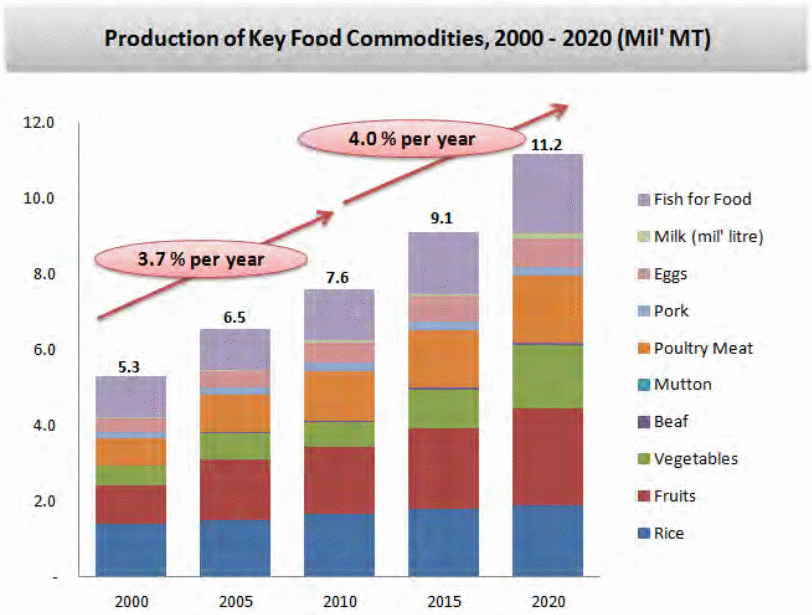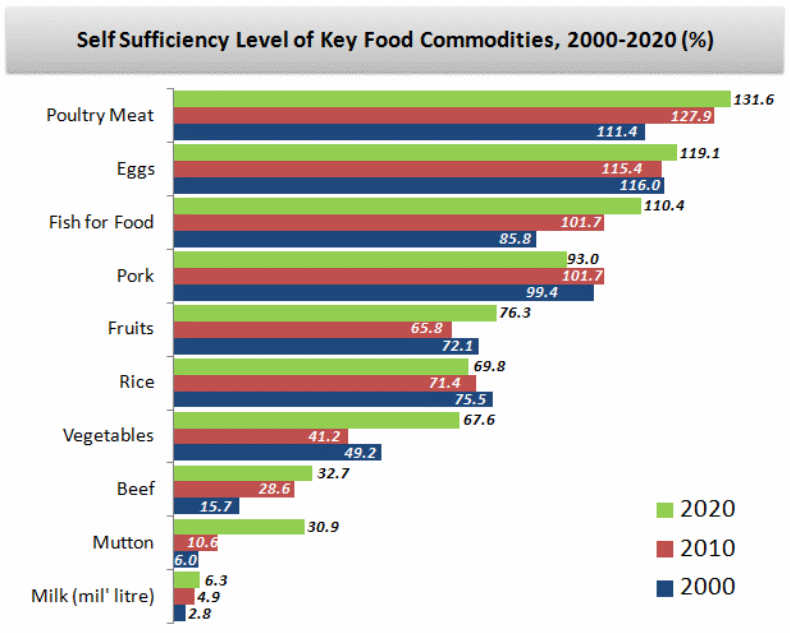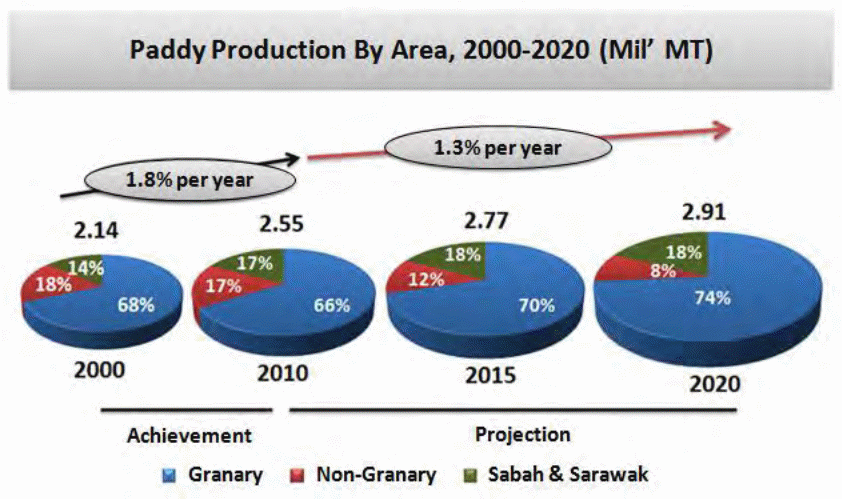Introduction
Food security is a subject that has attracted global attention, particularly in the third world economies. The World Food Program estimates that nearly one billion individuals are suffering from hunger and undernourishment. As the population keeps on growing, there is a need to enhance food production to take care of the ever-increasing demand and to avert food security threat.
Malaysia is one of the economies where food security is still a matter of concern. As a matter of fact, food self-sufficiency in the country is reducing day by day (Razak 2013). One of the main weaknesses of the Malaysian agricultural sector is its over-reliance on the production of cash crops with little attention to food crops (Ministry of Agriculture 2008).
According to the Ministry of Agriculture (2008, p. 12), the main challenge facing the agricultural sector is the lack of self-sufficiency in the production of food crops and over-reliance on food imports. In addition, the overall agricultural productivity in the country has also declined over the past three decades.
Figure 1 below shows the country’s agricultural productivity in relation to aggregate productivity. It is evident that the Malaysian agricultural GDP in relation to national GDP has declined from 23 percent to less than 10 percent (Bakar 2006). Therefore, it is important to look at the source of the decline in agricultural productivity and the reason behind the importation of food crops in Malaysia.
Figure 1: Agricultural Share of the national GDP (%)
Source: Bakar (2006, p. 339)
The National Agro-Food Policy 2011-2020
Before we explore the National Agro-Food Policy 2011-2020, it is important to understand the origin of the problems bedeviling the agricultural sector in the country. This will help us understand the goal and objectives of the policy. Most literature traces the decline in agricultural productivity in Malaysia to the 80s and the mid-90s, which they refer to as the “sunset era”.
In the 80s, the economy shifted from agriculture to manufacturing, whereas in the mid-90s the economy shifted from manufacturing to information communication technology (ICT) (Bakar, 2006). Therefore, the challenges facing the country’s agricultural sector are mainly attributed to the structural changes in the economy.
Due to improved and steady proceeds generate by the manufacturing industry, individuals in the public and private sectors opted to venture in the manufacturing sector as opposed to the agricultural sector. In addition, agribusiness was becoming riskier because of its vulnerability to external factors, which include adverse weather conditions and price fluctuations in the global market.
The scarcity of land was also a contributing factor. In fact, in the past three decades, land in Malaysia has become increasingly scarce. As a result, the government and private entities prefer to use the land for more profitable ventures. Moreover, those who ventures into agriculture preferred cash crop production.
Last but not least, acute shortage of labor also contributed to the decline in the agricultural production. There has been a tremendous exodus of labor from the agricultural sector to the industrial sector, particularly the youthful population. The industrial sector offers more lucrative wages than the agricultural sector.
Despite the fact that agriculture has been sidelined, it is still a significant part of the Malaysian economy. Prior to the introduction of National Agro-Food Policy 2011-2020, the country was spending well over RM 15 billion on food imports and this adversely affected its balance of trade.
As a result, the government introduced the National Agro-Food Policy 2011-2020 whose main objectives include self-sufficiency in food production, optimization of land use, increased participation of farmers in growing food crops, and an annual saving of $200 million on vegetable imports (Razak 2013). These objectives were to be met through four significant programs.
The first program emphasizes on land use and increasing the acreage of food crops. The second program focuses on the coordination of all the agricultural efforts from the village level to the national level through the department of agriculture and farmers association. The third program focuses on the advancement of marketing strategies through state and non-state agencies.
Lastly, the fourth program focuses on the implementation of all the programs from the local level to national level (Ministry of Agriculture 2012; Tey 2010; Harron Shamsudin & Latif 2001). In a nutshell, the National Agro-Food Policy 2011-2020 acts as a guiding principle for the country’s agricultural sector.
The previous policies focused on the commercialization of farming activities, streamlining farmers associations and agricultural banks, and rehabilitation of farm lands. On the other hand, the National Agro-Food Policy 2011-2020 emphasizes on food security and safety, increased the efficiency of food crop productivity, equitable investment in agriculture, growth and development of agricultural industries, and employment creation.
I guess the Malaysian government has realized that structural changes in the economy should not be used as an excuse to sideline agriculture. As a matter of fact, nearly all the industrialized economies, including the U.S. and Britain are self-sufficient in food production.
The Impact of the National Agro-Food Policy 2011-2020
Even though the aggregate agricultural output in relation to the country’s overall output has been declining in the past three decades, the production of key food commodities has been increasing though at a slow pace. However, the amount of food produced cannot meet the ever-increasing demand attributed to the rapid increase in population.
As a result, the deficit has to be bridged through food importation. The production of main food commodities in Malaysia is shown in figure 2. From the figure, you can see that the production of key food commodities from 2000 to 2010 has grown by approximately 3.7 percent per annum.
However, since the launch of the National Agro-Food Policy 2011-2020, the production has grown by over 4 percent per annum. The main focus is on rice, fruits, fish food and vegetables. Therefore, the National Agro-Food Policy 2011-2020 not only targets self-sufficiency in the production of food crops, but also improved nutrition.
The four components are nutritionally balanced because they contain carbohydrates, vitamins and proteins.
Figure 2: The past and projected production of main food commodities in Malaysia

Source: Ministry of Agriculture (2012, p. 11)
Figure 3: Self-Sufficiency Level of Principal Foods

The figure above shows the self-sufficiency level of the key food commodities since the inception of the National Agro-Food Policy 2011-2020 and the projected figures. It is very clear that the country is making significant strides towards the achievement of self-sufficiency in the production of key food commodities.
However, it is still lagging behind in the production of dairy products, vegetables, mutton, rice and fruits. It seems they will still have to import these food commodities in the next two decades to meet the domestic demand, which is very unfortunate.
Despite increasing the area under paddy rice by nearly 20 percent since 2010, the self-sufficiency level was still around 68.2 percent in early 2015, which is way below the projected value of 70 percent. This shows that the National Agro-Food Policy 2011-2020 still has weaknesses and has to be reviewed.
It should be noted that rice is a staple food in Malaysia and, therefore, can be used to benchmark the aggregate food production in the country. The government may argue that the low production level is attributed to the scarcity of land and labor. However, it is obvious that the government is not doing enough to improve the situation.
There are many countries facing similar challenges but are self-sufficient in food production. For example, Holland is exceedingly self-sufficient despite having the same problem. Food production in Holland is very much mechanized and this has helped the country to cope with the problem of labor shortage. In addition, Holland has gone ahead to reclaim all the potential farm land.
For instance, they have created mechanisms to increase agricultural farm lands. Moreover, the government has put more emphasis on the manufacturing sector and ICT sector because of its high returns.

Source: Ministry of Agriculture (2012, p. 11)
The Malaysian government’s move would be welcomed by many economists. If the manufacturing sector offers more opportunities than the agricultural sector, then it is prudent to pay less attention to the latter. This is based on the classical economic theory of comparative advantage, which refers to the opportunity cost of producing a given product compared to another country.
It basically refers to the value of trade between two countries. Therefore, if the cost of producing food crops in Malaysia is higher than importing them from the neighboring countries, then it is reasonable to import. However, this poses a huge risk for the country in terms of overdependence on other countries for key food commodities.
Conclusion
Agriculture in Malaysia is both a source of food and livelihood. In addition, the sector is essential to the country’s economy. However, the three decades have been characterized by low agricultural productivity as a result of structural changes in the economy.
This has forced the Malaysian government to spend massively on food imports. On the other hand, the ratio of agricultural output to aggregate output has dropped by more than 15 percent since 1980. This is despite the fact that the government had initiated key reforms in the agricultural sector.
However, these reform programs have not achieved their target. In late 2010, the Malaysian government ratified the National Agro-Food Policy 2011-2020 whose main aim was to make Malaysia a food secure country through the production of food crops.
Even though the National Agro-Food Policy 2010-2010 has not fully achieved its goals, it is gradually helping the country to reduce food imports by increasing the amount of local food production. However, a lot has to be done in order to meet the set targets.
References
Bakar, B 2006, The Malaysian Agricultural Industry in the New Millennium: Issues and Challenges, University of Malaysia.
Harron, M, Shamsudin, M & Latif, IA 2001, Challenges for Agribusiness: A Case for Malaysia, The Ministry of Agriculture and Cooperatives.
Ministry of Agriculture 2008, Follow-up of the Implementation of the World Food Summit Plan of Action, Ministry of Agriculture, Kuala Lumpur.
Ministry of Agriculture 2012, The National Agro-Food Policy, 2011-2020, Ministry of Agriculture, Kuala Lumpur.
Razak, MI, Hamzah, ASM, Abas, N, Idris, R & Ibrahim, Z 2013, ‘Sustaining Food Production for Security in Malaysia’, Journal of Economics and Development Studies, vol.1, no. 2, pp.19-25.
Tey, Y S 2010, ‘Malaysia’s strategic food security approach’, International Food Research Journal, 501‐507.